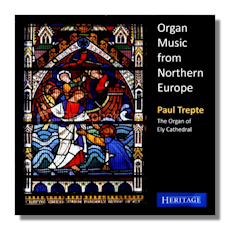
The Internet's Premier Classical Music Source
Related Links
-
Gade Reviews
Glazunov Reviews
Nielsen Reviews
Sibelius Reviews - Latest Reviews
- More Reviews
-
By Composer
-
Collections
DVD & Blu-ray
Books
Concert Reviews
Articles/Interviews
Software
Audio
Search Amazon
Recommended Links
Site News
 CD Review
CD Review
Organ Music from Northern Europe

- Jean Sibelius: Two Organ Pieces
- Niels Gade: Three Organ Pieces, Op. 22
- Alexander Glazunov:
- Fantaisie, Op. 110
- Prelude & Fugue in D Major, Op. 98
- Georgy Mushel: Toccata
- Carl Nielsen: Commotio
Paul Trepte, organ
Heritage HTGCD214 76min
This collation of organ works by composers from Northern Europe is somewhat of a rarity, if only for the reason that all of the names are famous for their symphonic literature. But as with most composers throughout the ages, the instrument cast its spell on the ones presented on this issue as well, and the results are highly enthralling if not wholly revealing.
The two Sibelius works are the only ones he composed for the organ. Written separately, but published together as, Op. 111, they do not remain long in the memory, although Sibelius' ability to write for the instrument is amply displayed. Glazunov's creations are imbued with a strong French flavor and are dedicated to Camille Saint-Saëns and Marcel Dupré respectively. In appreciation, the latter edited all of Glazunov's organ pieces, thus rendering the Russian a great service. The "Toccata" by Georgy Mushel, also a Russian, is the shortest work on the programme, but its rhythmic vitality reminiscent of Uzbek folk music, makes it a colourful and totally accessible composition.
The legacy of Niels Gade and Carl Nielsen is that of having raised the Danish symphony to the highest levels of achievement, the former in the 19th century, the latter in the 20th. Gade's Op. 22 are overtly romantic creations, but moments of intellectual rigour betray the influence of the Victorian English style. Nielsen's "Commotio" is the very last piece that he composed, and is the only work among this cluster that still holds a foothold in the repertoire. It is a rousing and exciting experience and it displays Nielsen's mature and imaginative language full of motivic invention and original textures.
Paul Trepte's performances are vibrantly exciting, and his insight of this rare repertoire serves the music marvelously well. This is unusual stuff worthy of serious investigation.
Copyright © 2011, Gerald Fenech


















